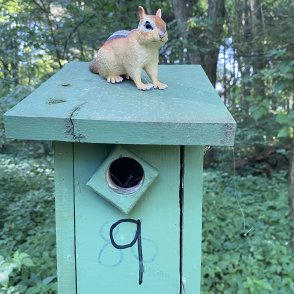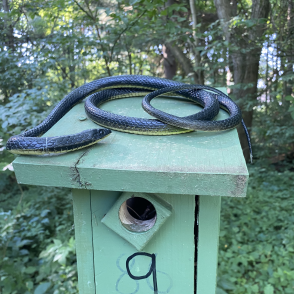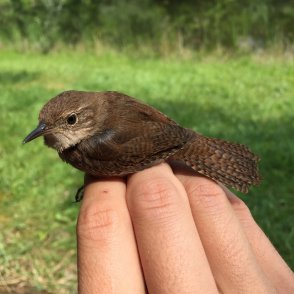It's Inauguration Day!
Congratulations, Matt vandenBerg, OWU's 17th President!
View details for Inauguration Day and stream the event live.
Congratulations, Matt vandenBerg, OWU's 17th President!
View details for Inauguration Day and stream the event live.

This project aimed to study how nest defense behaviors of house wrens are similar against predators that commonly feed on house wren eggs and nestlings and whether the strength of their defense relates to reproductive success. We used plastic predator models of an eastern chipmunk and black rat snake to simulate an attack on the nest box to get the parents to perform nest defense behaviors, and counted the number of times that the parents performed certain behaviors, such as flying over and attacking the fake predator. We then used statistical tests to determine if there was consistency in the bird’s anti-predator behavior, and if there was a significant relationship between those behaviors and reproductive success. Interestingly, there was no significant difference in responses of individual parents even though the predator models were very different from each other.
Dr. Dustin Reichard and Dr. Elizabeth Schultz
Do female house wrens exhibit behavioral plasticity in their responses to differing nest predation threats?
Offspring predation is one of the greatest obstacles to an organism’s reproductive success. Individual parents vary greatly in their risk-taking behavior in response to a predator, as investing more energy while defending current offspring has the potential to lower future reproductive success if the predator is also capable of injuring or killing the parent as well as the nestlings. House Wrens (Troglodytes aedon) are small, cavity-nesting songbirds that have clutches of up to 8 offspring. Common nest predators include rodents, predatory birds, and snakes. Here, we used two different predator decoys, an eastern chipmunk (Tamias striatus) and a black rat snake (Pantherophis alleghaniensis), to elicit nest defense behavior and test whether parents are consistent in their anti-predator response and whether that response affects fitness. We hypothesized that parents would respond consistently to each predator model, as previous research has shown that birds are able to assess predation risk in known predators. Interestingly, even though the predator models were very different animals, anti-predator behaviors were not significantly different between the models. However, there was a significant weak negative correlation between time spent within five meters of the model and the number of offspring produced. This result contradicts our prediction that greater investment in anti-predator behavior should yield higher reproductive success.
Offspring predation is a critical concern that individuals must overcome in order to ensure their reproductive success. Risk-taking behavior in response to predators by parents vary greatly between individuals; higher investment in the offspring may increase the chance that offspring survive, but may also decrease lifetime reproductive fitness if the parent is injured or killed during the risk-taking behavior¹.
House wrens, a small, cavity-nesting species of songbird that have clutches of up to 8 offspring, commonly encounter nest predators such as rodents, predatory birds, and snakes.
The eastern chipmunk (Tamias striatus) and the black rat snake (Pantherophis alleghaniensis) are known predators of house wren offspring and are unlikely to predate on House Wren adults, while other predators such as sharp shinned hawks (Accipiter striatus) or Cooper’s hawks (Accipiter cooperii) are more likely to prey on adults as well as offspring.²
We hypothesized that parents would respond consistently to models of predators that posed nest predation threats, as previous research has shown that birds are able to assess predation risk in known predators.³
Two different predator decoys, an eastern chipmunk (Tamias striatus) and a black rat snake (Pantherophis alleghaniensis), were used to elicit a nest defense behaviour. The birds were presented with one predator, then on the following day the next predator was presented. Predator presentation order was alternated.
A series of metrics were designed in order to quantify anti-predator behaviours, such as number of flyovers and strikes, flyover and strike rate, and time spent within five meters of the nest box
Each trial was also video recorded to ensure that the behaviours were measured correctly
The statistical program R was used to analyze the data, using a Linear Mixed Model Approach and paired t-tests.
No significant differences were observed in anti-predator behavior between the models.
There was a weak negative correlation between time spent within five meters of the box and the number of offspring produced.
Predator presentation order had no significant effect on response.
Sample size was 94 total trials, on 47 nesting pairs.
Table 1
| Linear mixed model | t-value | p-value | Chi squared |
| Nestling number | - | 0.98463 | 0.0004 |
| Time within 5 meters | - | 0.9217 | 0.0097 |
| Flyover Rate | - | 0.1532 | 2.0405 |
| Hit Rate | - | 0.2908 | 1.1159 |
| Flyovers | - | 0.9425 | 0.0052 |
| Hits | - | 0.6493 | 0.2068 |
| Paired T-tests | t-value | p-value | Figures |
| Flyover rate | 1.1599 | 0.2521 | 2 |
| Hit rate | 1.2389 | 0.2217 | 1 |
| Hits | -0.13255 | 0.8951 | 4 |
| Time within 5 meters | 0.47989 | 0.6336 | - |
| Closest Approach | -0.4352 | 0.6655 | 3 |
| Pearson Correlation | t-value | p-value | - |
| Time within 5 meters | -2.3517 | 0.02312 | 5 |
House wren individuals exhibited highly varied responses to nest predators from each other; some females were extremely aggressive while others showed only minimal interest in nest defence
House Wren individuals responded to both predators consistently across both trials
In clutches of smaller size, adults spent significantly more time outside of 5 meters, which may have been the result of the risk of self harm outweighing the risk of loss of offspring. This is surprising because it contradicted one of our initial predictions that parents would be more invested in smaller-clutch offspring into which parents have invested more resources.
It is interesting that there was not a relationship between fitness and anti-predatory behavior. This may arise from cavity-nesting species like house wrens having a more secure and safe nest as opposed to other species that nest in different areas such as higher in the canopy, close to the ground or even burrowing underground. There may also be some connection to the hormone prolactin, which helps regulate parental behavior in multiple species of organisms
In the future, it would be interesting to determine if there is a hormone such as corticosterone or testosterone that regulates the type and strength of the anti-predator behaviors. This could be done possible through doing similar behavior trials, then capturing the parents immediately after the trial and taking a blood sample to measure levels of different hormones present in the blood to see correlations. It would also be interesting to add a large predatory bird model that poses a larger risk for adult house wrens to see if risk-weighing plays a role in anti-predatory behavior.
Thank you to Dr. Reichard and Dr. Schultz for their guidance on this project, and to Kyle Davis for his amazing help during the research. Thank you also to the Davis family, the Fink family, and the Tabak family for providing additionally research sites.
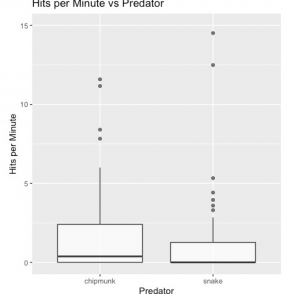
rate of strikes per minute by female parent house wren on each predator (t = 1.2389, p-value = 0.2217)
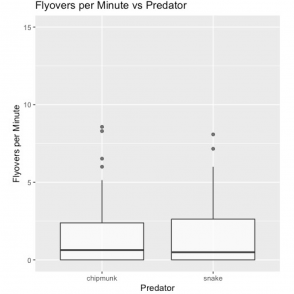
rate of flyovers by female parent house wren on each predator (t = -0.13255, p-value = 0.8951)
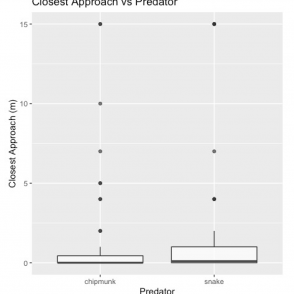
closest approach by female parent to the predator model during trial time. females that struck the decoy were given a value of zero. (t = -0.4352, p-value = 0.6655)
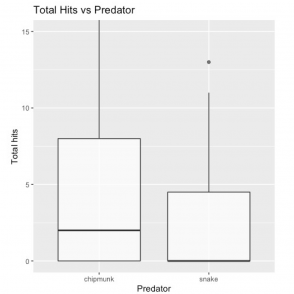
total strikes of female parents for each predator (t = -0.13255, p-value = 0.8951)
